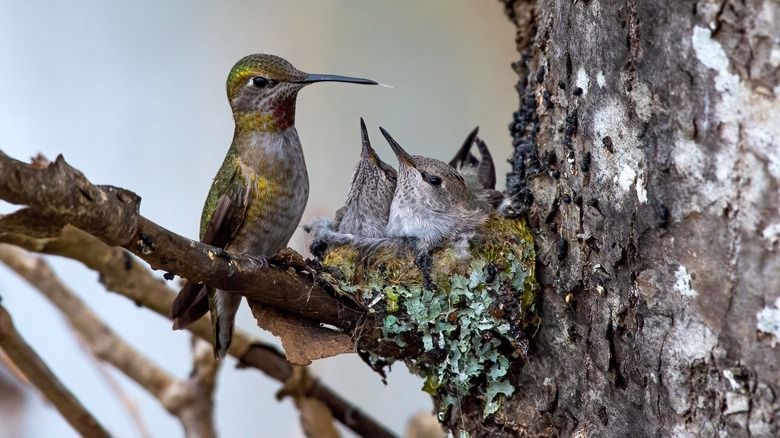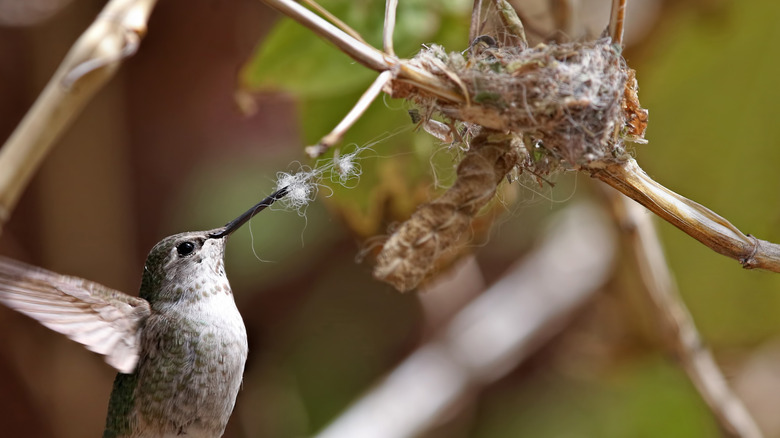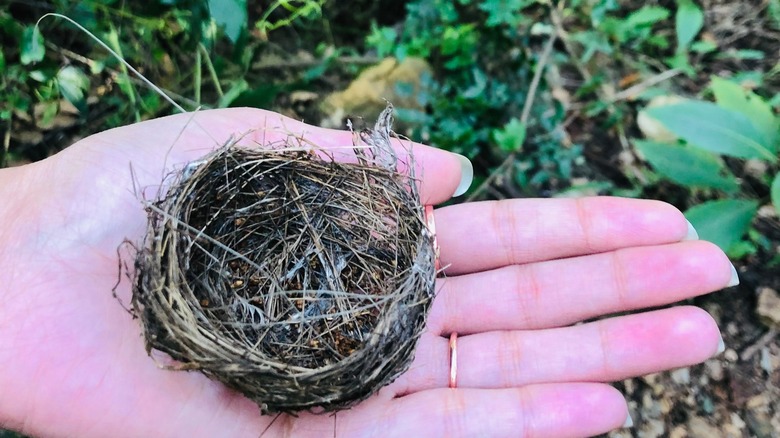Will Hummingbirds Reuse The Nest Made In Your Yard Or Garden?
Ever wondered why hummingbirds aren't using your birdhouse? You might be surprised to learn that these teeny feathered garden visitors don't like to build nests in them. Instead, they construct thimble-sized baby hummer homes on branches, under house eaves, and other hidden away places. Do they reuse old nests? The short answer is sometimes! It depends on the species of hummer, where and what time of year they're nesting, and other circumstances. Some hummingbirds reuse nests or build a new nest right on top of an old one. Others reuse nest materials to build new nests (or steal materials from other birds' nests), while some don't reuse, steal, or rebuild anything. They simply build an entirely new nest.
Female hummingbirds build their cup-like nests from bits of lichen and moss, sticks, plant fibers, down, and, in fairy-like fashion, spiderwebs. The nests are perched high up — between 10 and 90 feet — in trees, typically, though some species also nest on other structures. They are designed to be extremely well camouflaged in their surroundings but, due to their incy-wincy size, they're pretty fragile. The nests don't usually last more than a season unless built somewhere well protected from the elements, various predators, and natural processes like rot. As such, many sources state that hummingbird nests are not frequently reused, and that's true to some degree. However, it really depends on the species of hummer — after all, more than 15 hummingbird species frequent North America.
Only some species of hummingbird reuse their nests
It takes a lot of energy to build a nest for any bird, let alone one of the avian world's littlest members; reusing nests is a smart use of resources. Species of hummingbirds known to reuse nests include scintillant hummingbirds (which build new nests on top of old ones), rufous hummingbirds (not always the same bird), ruby-throated hummingbirds (for a second brood), and calliope hummingbirds. Sometimes, one hummingbird species reuses another's nest. Whether a hummer decides to reuse a nest depends on its location and state of preservation. In a 2020 Wilson Journal of Ornithology paper, researchers suspected multiple generations of black-chinned hummingbirds were reusing nests located inside an El Paso hardware store because they were well protected.
Other species recycle old nests to make new ones or steal nest materials from existing ones. A report published in the October 1972 edition of The Condor discusses broad-tailed hummingbirds and Anna's hummingbirds engaging in recycling. Blue-throated Mountain-gems are also known to engage in this behavior. Some hummers return to the same nest site year after year, but not necessarily the same exact nest or even in the same trees and shrubs. Species inclined to do this include ruby-throated hummingbirds, Costa's hummingbirds, rufous hummingbirds, Allen's hummingbirds, black-chinned hummingbirds, and broad-tailed hummingbirds. All this to say, leaving nests in situ or even protecting them so they last until the following season is one way you can support hummingbirds in your garden during migration seasons.
Encourage hummingbirds to nest in your backyard
Hummingbird nests are usually well hidden, so it's rare to stumble across one. Gardeners find them while pruning bushes or when doing maintenance — cleaning gutters, sorting out the shed, or sweeping cobwebs from under-roof eaves. If you encounter a hummingbird nest that's still in use, leave it be. It's illegal to move or destroy active nests or remove eggs. Empty nests are a different story. Ideally, it's best to simply leave the nest where you found it. As you've now learned, it may serve as a new nesting spot or provide upcycled nest material for a tired hummer mom or a future nesting season. If you knocked the nest from its perch, put it back as near as possible to where you think the original location might have been. If the nest is clearly empty and heavily damaged, you can remove it.
Another way to encourage hummingbirds to bring their babies up in your yard is to provide lots of food and fresh water. Mamma hummers don't want to have to travel too far for subsistence for themselves or their chicks. Plant lots of insect-attracting and nectar-filled flowering plants, and hang hummingbird nectar feeders. These tiny avian garden residents prefer equally small pools of water or misters to heft bird baths. On that note, should spider webs be removed from hummingbird feeders? Since hummers use cobwebs as nest-building material, there's an argument to be made for leaving them where they are!


